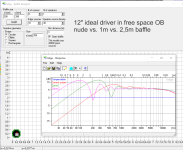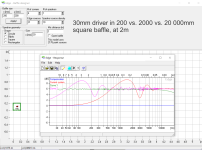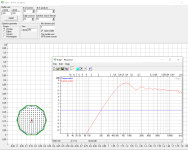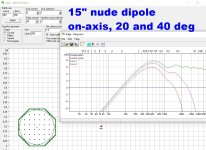Great will give it a go tomorrow, your finding are interesting, if it works for me I will definitely buy the beers 

Background
See attached 2 (rather dusty) photos of an old open baffle opposing-driver sub-woofer project, I want to resurrect.
It uses:
In the past I drove this speaker with a stereo amp, one channel (same signal) to each driver.
- a pair of 15" PrueAudioProject woofers, which PureAudioProject had Eminence optimize for open baffle.
- spacers to connect the drivers
- wrought iron table legs from which to hang the drivers
- rubber tie downs as the suspension
Of note, in this kind of speaker, one needs to connect the drivers out-of-phase.
It worked great and matched very well with my large aluminum honeycomb DML main stereo speakers.
Next step
I have all the parts to construct a second one of these.
I don't have an extra stereo amplifier.
Key specifications of the drivers:
View attachment 1367434
Questions
I have a stereo amp: Hypex NCore 2x125W 4 Ohm
I used this amp to drive this sub in the past (one channel to each driver)
Can I use this amp to drive two of these open baffle opposing-driver sub-woofers (each has 2 drivers)?
If yes, how do I wire them to the drivers (especially given I need each subs drivers driven out of phase).
Alternatively, I can buy another Hypex NCore 2x125W 4 Ohm, but I'd rather not if I don't have to.
Thoughts appreciated.
The specs for your amp modules can be found here:
https://www.hypex.nl/products/amplifier-families/mains-powered-ncore-family/nc252mp-oem
You have two amp channels, and each driver is 8 Ohms nominal. If you want to be able to have stereo operation, you have to use one channel "per side" and there are two drivers per side. The solution is to just wire the drivers in parallel, taking care to reverse the phase of one of them so both cones move in the same direction. This sort of driver arrangement is called a nude compound dipole. There is a whole thread on this somewhere in these forums.
The more baffle you use, the less LF losses. Usually the nude configuration is used when you want to operate the drivers as high in frequency as possible. In any case it is a relatively small and compact dipole system and with the proper equalization they can sound very nice, albeit at only modest maximum SPL levels.
This opposing nude woofers arrangement has bothered me for many years.... I really don't see any bebefit in it. Perhaps during the end of this week I can make a proto with two leftover 8" that lie around and measure it. Opposed woofers in a box is simple to understand.
Another mystery to me is woofer "slot loading". My guts say that it boosts only in extreme nearfield...
Another mystery to me is woofer "slot loading". My guts say that it boosts only in extreme nearfield...
The benefit is reduced even order distortion, if that matters.
John knows better (with math skills!), but isobaric basically doubles the motor force to produce same spl. As well some nonlinearities in motor T/S won't become so prominent. Still same excursion is needed for similar spl. connecting parallel or serial affects impedance which has secondary effects to motor/amplifier co-operation.
Isobaric box was used more often before woofer "motors" bot better and amplifier wattage cheaper.
Nude opposing drivers with open cavity between cones is something that I don't understand "why". In-phase is waste of resources with modern drivers IMO. Opposite phase creates a quadrupole which is extremely different animal - backside of cones radiate haphazardly and cavity is pumping air in-between. Frequency/wavelenth change creates many interferences but different summation/cancellations...
https://www.acs.psu.edu/drussell/demos/rad2/mdq.html
https://www.acs.psu.edu/drussell/demos/rad2/latquad.gif
Isobaric box was used more often before woofer "motors" bot better and amplifier wattage cheaper.
Nude opposing drivers with open cavity between cones is something that I don't understand "why". In-phase is waste of resources with modern drivers IMO. Opposite phase creates a quadrupole which is extremely different animal - backside of cones radiate haphazardly and cavity is pumping air in-between. Frequency/wavelenth change creates many interferences but different summation/cancellations...
https://www.acs.psu.edu/drussell/demos/rad2/mdq.html
https://www.acs.psu.edu/drussell/demos/rad2/latquad.gif
Nude opposing drivers with open cavity between cones is something that I don't understand "why". In-phase is waste of resources with modern drivers IMO.
I know what you mean, and I've never actually tried it. But I might, one day, when I have time.
One argument in favour of nude OB drivers is that it maximises radiating area, for a given baffle size, which optimises the radiation pattern both up to and beyond the dipole peak. And if you're going to use nude drivers, for low frequencies, it makes sense to use big ones, in multiples. Arranging them one behind the other keeps everything compact. (And at low frequencies, the distance between the drivers isn't an issue, because wavlengths are so long.)
Last edited:
Not sure I get this one, won't the back wave then more destructively couple? It is easy to see when driving and open baffle with no baffle and just partly placing it on a table's edge make a huge difference in level.
I agree, it doesn't seem entirely intuitive. But it's what those who know seem to say.
Here's a reference: https://www.linkwitzlab.com/models.htm#B1
See also the links in posts 15 and 20. Or look up the Celestion 6000 online - not nude drivers. but minimal baffles.
Here's a reference: https://www.linkwitzlab.com/models.htm#B1
See also the links in posts 15 and 20. Or look up the Celestion 6000 online - not nude drivers. but minimal baffles.
I guess we have to believe in the gospel without question, else something we have no proof of either may ruin your last day.
It's not a matter of believing something without question. There's reasoning and evidence in the links people have provided. If you think everyone else is wrong, maybe try explaining where they've gone wrong, why the measurements people have done are wrong etc.
I posted on the thread to answer the OP's questions, and then to respond to your questions. I'm trying to be helpful, with what (limited) understanding I have, so I'm not sure why you're having a go at me.
I posted on the thread to answer the OP's questions, and then to respond to your questions. I'm trying to be helpful, with what (limited) understanding I have, so I'm not sure why you're having a go at me.
Offtopic - for Nico
Please search studies of Mellow&Kärkkäinen - driver vs baffle ratio
https://acris.aalto.fi/ws/portalfil...low_On_the_scattering_of_disk_source_JASA.pdf


Please search studies of Mellow&Kärkkäinen - driver vs baffle ratio
https://acris.aalto.fi/ws/portalfil...low_On_the_scattering_of_disk_source_JASA.pdf


Thanks Juhazi, you make it perfectly clear. Which graph would apply to a baffle of 0 sq meter.
Last edited:
Oh cr@p Juhazi, I did not realize you were the author of this Mellow&Kärkkäinen dissertation writing under an alias.
Actually the link I gave was not the one I meant (I'm Juha, not Tim ar Leo), sorry. Anyone can ask help from Tim https://www.frontro.co.uk/mellow-acoustics
The right one with pics is here https://www.semanticscholar.org/paper/On-the-sound-field-of-an-oscillating-disk-in-a-open-Mellow-Kärkkäinen/460d1b61e116d50ad3ed136152d8176e9984c28e

A cone or dome make deviations from ideal flat pistonic model. They can ce calculated too... Here is a peek to that issue by W. Klippel
https://www.klippel.de/fileadmin/_migrated/content_uploads/KLIPPEL_Sound_Radiation_Poster_01.pdf
Edge sim of a nude woofer


The right one with pics is here https://www.semanticscholar.org/paper/On-the-sound-field-of-an-oscillating-disk-in-a-open-Mellow-Kärkkäinen/460d1b61e116d50ad3ed136152d8176e9984c28e
A cone or dome make deviations from ideal flat pistonic model. They can ce calculated too... Here is a peek to that issue by W. Klippel
https://www.klippel.de/fileadmin/_migrated/content_uploads/KLIPPEL_Sound_Radiation_Poster_01.pdf
Edge sim of a nude woofer


Last edited:
So Ian is this the conclusion:
The whole arrangement does not strike me as a very effective use of a second driver and cabinet space compared to an H or W frame. I have no data how high in frequency the "compound woofer"can be used, but its radiation pattern will become more lobing than that of the two point source woofer.
Or rather Siegfried does not know. I can not recall him as having answers to everything while working with him. He was just another DIYaudio enthusiast.
So in effect this new arrangement is just another nebulous idea from a kitchen table scientist thinking he hit the jackpot
The whole arrangement does not strike me as a very effective use of a second driver and cabinet space compared to an H or W frame. I have no data how high in frequency the "compound woofer"can be used, but its radiation pattern will become more lobing than that of the two point source woofer.
Or rather Siegfried does not know. I can not recall him as having answers to everything while working with him. He was just another DIYaudio enthusiast.
So in effect this new arrangement is just another nebulous idea from a kitchen table scientist thinking he hit the jackpot
Please KILL the thread, it is just becoming an challenge among the obnoxious who believe that "their listening acumen" is the only valid proof of anything.
Why should we deny the smart guys the right to counter conflicting or wrong arguments with facts? 🙂
I have met Siegfried Linkwitz once in 2013, a very nice gentleman was he! His basic science was allpied mathematics, in microchip world. His personal interest was in loudspeakers evolved to many wonderful things like Linkwitz-Riley crossovers and dipole loudspeaker development. His was open to other's ideas and adapted them after digesting all his life. Eg. His early dipole speakers had constant frame width, but after realizing baffle width effect to off-axis radiation he designed his LX521. Best of all he was systematic and wanted to share his learned skills to everyone via his homepage www.linkwitzlab and by numerous presentations at events and open house at his home.
John Kreskovsky (https://www.diyaudio.com/community/members/john-k.15987/#about) was even ahead of him in dipole design and still contributes at diyaudio sometimes. His homepage is still available at https://musicanddesign.speakerdesign.net/products.html
My third dipole guru is Rudolf Finke http://www.dipolplus.de/ https://www.diyaudio.com/community/members/rudolf.4207/#about
John Kreskovsky (https://www.diyaudio.com/community/members/john-k.15987/#about) was even ahead of him in dipole design and still contributes at diyaudio sometimes. His homepage is still available at https://musicanddesign.speakerdesign.net/products.html
My third dipole guru is Rudolf Finke http://www.dipolplus.de/ https://www.diyaudio.com/community/members/rudolf.4207/#about
Last edited:
- Home
- Loudspeakers
- Subwoofers
- Driving an open baffle opposing-driver sub-woofer